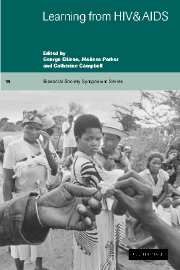Book contents
- Frontmatter
- Contents
- List of contributors
- Foreword by D. Clarke-Patel
- 1 Introduction. Learning from HIV and AIDS: from multidisciplinary to interdisciplinarity
- 2 HIV and the evolution of infectious diseases
- 3 The epidemiology of HIV/AIDS: contributions to infectious disease epidemiology
- 4 The influence of HIV/AIDS on demography and demographic research
- 5 What have clinicians learnt from working with HIV/AIDS? A medical perspective from London
- 6 How has the HIV/AIDS pandemic contributed to our understanding of behaviour change and health promotion?
- 7 Anthropological reflections on HIV prevention strategies: the case for targeting London's backrooms
- 8 An absence of anthropology: critical reflections on anthropology and AIDS policy and practice in Africa
- 9 A disaster with no name: the HIV/AIDS pandemic and the limits of governance
- 10 Postscript: reflections on HIV/AIDS and history
- Country index
- Subject index
- References
5 - What have clinicians learnt from working with HIV/AIDS? A medical perspective from London
Published online by Cambridge University Press: 14 January 2010
- Frontmatter
- Contents
- List of contributors
- Foreword by D. Clarke-Patel
- 1 Introduction. Learning from HIV and AIDS: from multidisciplinary to interdisciplinarity
- 2 HIV and the evolution of infectious diseases
- 3 The epidemiology of HIV/AIDS: contributions to infectious disease epidemiology
- 4 The influence of HIV/AIDS on demography and demographic research
- 5 What have clinicians learnt from working with HIV/AIDS? A medical perspective from London
- 6 How has the HIV/AIDS pandemic contributed to our understanding of behaviour change and health promotion?
- 7 Anthropological reflections on HIV prevention strategies: the case for targeting London's backrooms
- 8 An absence of anthropology: critical reflections on anthropology and AIDS policy and practice in Africa
- 9 A disaster with no name: the HIV/AIDS pandemic and the limits of governance
- 10 Postscript: reflections on HIV/AIDS and history
- Country index
- Subject index
- References
Summary
Introduction
This chapter sets out to provide a narrative account of learning from HIV and AIDS drawn from the perspective of a clinician (CW) who has been working with HIV/AIDS patients in London since 1990. It draws on CW's clinical experience gained during his initial specialist HIV training at the Chelsea and Westminster Hospital in Central London from 1990 to 1993, and on his experiences of working at the HIV Unit at the North Middlesex University Hospital (NMUH), a district general hospital in Edmonton), and in the Sexual Health Centre at St Ann's Hospital in Tottenham, both in North London. The community served by these two hospitals might best be described as ‘inner–outer London’ – a multicultural, multiethnic community with a large and diverse population comprising long-term residents and recent immigrants, including refugees and asylum seekers, living in an area with high levels of social deprivation, unemployment and welfare support. This local community happens to reflect the pattern of HIV infection globally and therefore provides an ideal setting from which to consider the impact of the disease on clinical perspectives and clinical practice, as well as some of the social and cultural dimensions of HIV/AIDS in the UK.
By reflecting on clinical practice this chapter aims to demonstrate how, despite the changing clinical context of HIV/AIDS in London, the barriers to treatment and therapy are common to many of the groups most at risk.
- Type
- Chapter
- Information
- Learning from HIV and AIDS , pp. 111 - 147Publisher: Cambridge University PressPrint publication year: 2003
References
- 7
- Cited by



